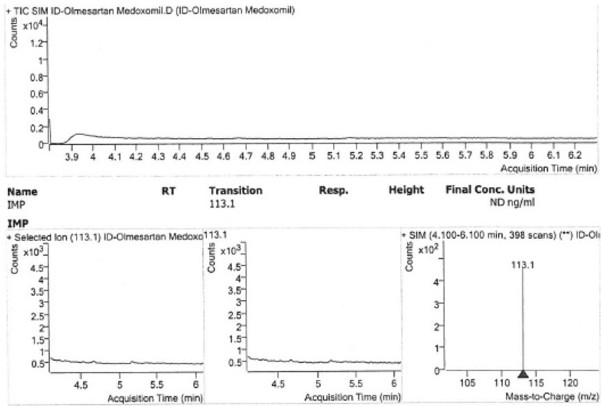Method for detecting 4-chloro-4-methyl-5-methylene-1, 3-dioxolane-2-ketone
A detection method and a technique for dioxolane, applied in the field of gas phase-tandem mass spectrometry
- Summary
- Abstract
- Description
- Claims
- Application Information
AI Technical Summary
Problems solved by technology
Method used
Image
Examples
Embodiment 1
[0068] Embodiment 1 detection method
[0069] Instrument conditions and reagents
[0070] Instruments: gas chromatograph, autosampler, Agilent GC\MS QQQ 7000D equipped with EI ion source, electronic analytical balance
[0071] Chromatographic column: capillary column with (14%-cyanopropyl-phenyl)-methyl polysiloxane as the stationary liquid (such as: AgilentDB-1701, 30 m x 0.25 mm, 1 μm or a column with equivalent performance)
[0072] Column temperature: the initial temperature is 150°C, keep for 1 minute; raise the temperature to 200°C at a rate of 35°C per minute, keep for 5 minutes; raise the temperature to 250°C at a rate of 30°C per minute, and keep for 3 minutes.
[0073] Injection port temperature: 130°C Carrier gas: He
[0074] Split mode: split Carrier gas flow: 1mL / min
[0075] Split ratio: 10:1 GC run time: 12.095min
[0076] Injection volume: 1µL
[0077] Mass Spectrometry Conditions:
[0078]
[0079] Reagents and reference substances
[0080] Chlorofor...
Embodiment 2
[0100] Embodiment 2 System Applicability
[0101]System suitability is determined by the S / N of 4-chloro-4-methyl-5-methylene-1,3-dioxolane-2-one in the sensitivity solution and 6 against 4-chloro- 4-methyl-5-methylene-1,3-dioxolane-2-one peak area is achieved by RSD, requiring sensitivity solution 4-chloro-4-methyl-5-methylene- The S / N of 1,3-dioxolane-2-one should not be less than 3,6 for 4-chloro-4-methyl-5-methylene-1,3-dioxolane in the reference solution The RSD of the -2-ketone peak area should not be greater than 10.0%. In order to confirm the system suitability during the sequence operation, inject a freshly prepared reference solution every 8 hours or at the end of the sequence during the verification process. The RSD of the peak area per unit concentration of 4-chloro-4-methyl-5-methylene-1,3-dioxolan-2-one in the reference solution for 6 consecutive points should not be greater than 10.0%; if it exceeds this range, An evaluation survey should be done.
[0102] Th...
Embodiment 3
[0106] Example 3 specificity
[0107] Specificity is determined by determining whether the blank solution interferes with the detection of 4-chloro-4-methyl-5-methylene-1,3-dioxolane-2-one, and 4-chloro-4- The separation between methyl-5-methylene-1,3-dioxolan-2-one and adjacent peaks is achieved; the blank solution is required to have no interference with the detection, and 4-chloro-4-in the selective solution The separation between methyl-5-methylene-1,3-dioxolane-2-one and adjacent impurity peaks should not be less than 1.5, and 4-chloro-4-methyl-5- The recovery rate of methylene-1,3-dioxolan-2-one should be between 80.0% and 120.0%.
[0108] The solution was prepared, and samples were injected according to the conditions of Example 1. The test results are shown in Table 9 and Table 10.
[0109]
[0110]
[0111] Wherein, need testing product brings into peak area=need testing product solution peak area ÷ need testing product solution sampling volume * selective sol...
PUM
| Property | Measurement | Unit |
|---|---|---|
| recovery rate | aaaaa | aaaaa |
Abstract
Description
Claims
Application Information
 Login to View More
Login to View More - R&D
- Intellectual Property
- Life Sciences
- Materials
- Tech Scout
- Unparalleled Data Quality
- Higher Quality Content
- 60% Fewer Hallucinations
Browse by: Latest US Patents, China's latest patents, Technical Efficacy Thesaurus, Application Domain, Technology Topic, Popular Technical Reports.
© 2025 PatSnap. All rights reserved.Legal|Privacy policy|Modern Slavery Act Transparency Statement|Sitemap|About US| Contact US: help@patsnap.com



